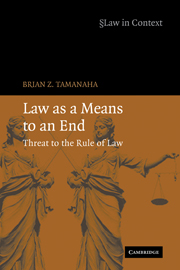Epilogue
Published online by Cambridge University Press: 25 July 2009
Summary
To forestall a fundamental misunderstanding of this book – one easy to fall into given its emphasis on the untoward consequences of moving from a non-instrumental to an instrumental view of law – let me first make clear what I am not arguing. I am not advocating a return to former non-instrumental understandings of law, which appears impossible. Nor am I a legal romanticist inclined toward a utopian view of the reality that accompanied former non-instrumental understandings of law. I do not vouch for the veracity of claims that law embodied principle, reason, and the customs and order of the community. Indeed, I explicitly noted that the common law claim to represent customs from time immemorial was largely a fiction, and I observed that what were identified as natural law principles often merely reflected and bolstered the status quo. Non-instrumental versions of law were guilty of their own sins. Two centuries ago and before, law inured to the benefit of the powerful and was often draconian and intolerant of dissent. To the extent that, under non-instrumental views of law, there was less overt conflict over law and greater apparent consensus within society, this was to some degree the result of an enforced homogeneity in the socio-legal order which suppressed or eliminated contrary groups, granting them little or no recognition within the law.
As suggested by the radical skeptic in the Introduction (and again in Chapter 2), self-described non-instrumental law was instrumental in its own way.
- Type
- Chapter
- Information
- Law as a Means to an EndThreat to the Rule of Law, pp. 246 - 250Publisher: Cambridge University PressPrint publication year: 2006

